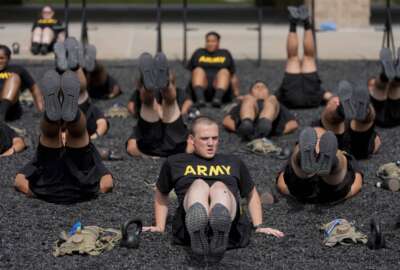Army ups its recruitment targets by thousands in 2025
The service barely surpassed its target in 2025 after years of recruiting shortfalls. It now wants to recruit 61,000 new soldiers in 2025.
After falling short of its recruitment goals for years, the Army barely met its recruitment targets in fiscal 2024. Now, it wants to increase its recruitment by thousands of new soldiers in 2025.
The service surpassed its goal to recruit 55,000 new soldiers in 2024 by only 300 recruits and exceeded its goal to bring 5,000 into the delayed entry program. Now, the goal is to recruit 61,000 new soldiers into the Army’s ranks in 2025 and send 10,000 people into the delayed entry program.
“This goal is ambitious, but we believe it is achievable,” Army Secretary Christine Wormuth said during the opening ceremony at the Association of the United States Army conference Monday.
“It’s no secret that the Army — along with our sister services — has had some significant recruiting challenges. These challenges are not going away. Fewer than a quarter of Americans are eligible for military service, and fewer than ten percent of young people are interested in serving. Unemployment is at a historic low — more than sixty percent of high school graduates are going straight to college, and many young people know very little about the Army or what we offer. We had no choice but to go on a full-court press to change how we recruit from top to bottom.”
While multiple factors contributed to this year’s success, the future soldier preparatory course has been one the most effective initiatives that is helping the service to turn things around. The program prepares recruits for basic training by helping them meet physical or academic requirements. The program has been a “huge” success — so far, it boasts a 95% success rate.
The service now has more than 11,000 people in its delayed program, partly due to the future soldier prep course, which is already giving recruiters a head start for 2025. The delayed program allows recruits to enlist and delay their active duty start date in order to finish high school or college.
“For young Americans who had the desire to join the Army but not the test scores, we created the Future Soldier Prep Course to give them a path to meet our standards. These efforts paid off in the fiscal year that just ended,” said Wormuth.
Wormuth also touted the artificial intelligence tool the service started experimenting with to help recruiters generate refined prospect lists rather than cold-call potential prospects. The tools helps recruiters analyze large volumes of data and identify individuals who show propensity for military service. The pilot currently runs in five cities — Buffalo, New York; Sacramento, California; Homewood, Illinois; New Orleans, Louisiana; and Fort Worth, Texas.
Madison Bonzo, the Army Recruiting Command media relations chief, told Federal News Network while feedback from the five participating recruiting companies is limited since the initiative is in its early stages, recruiters have already found the tool “promising.”
The first wave of data analysis is expected in late Fall 2024. Based on feedback and analytics, Army leaders will determine whether the initiative should be scaled up.
“As they find new techniques that deliver results, we are going to scale them across our recruiting brigades,” said Wormuth.
Wormuth said starting in January, the service will pilot the new approach in Miami.
“These recruiters won’t be in the recruiting station doing time-consuming administrative tasks.
Instead, they will spend their time out in Miami, sharing their passion for the Army with
potential new soldiers,” said Wormuth.
Copyright © 2025 Federal News Network. All rights reserved. This website is not intended for users located within the European Economic Area.






